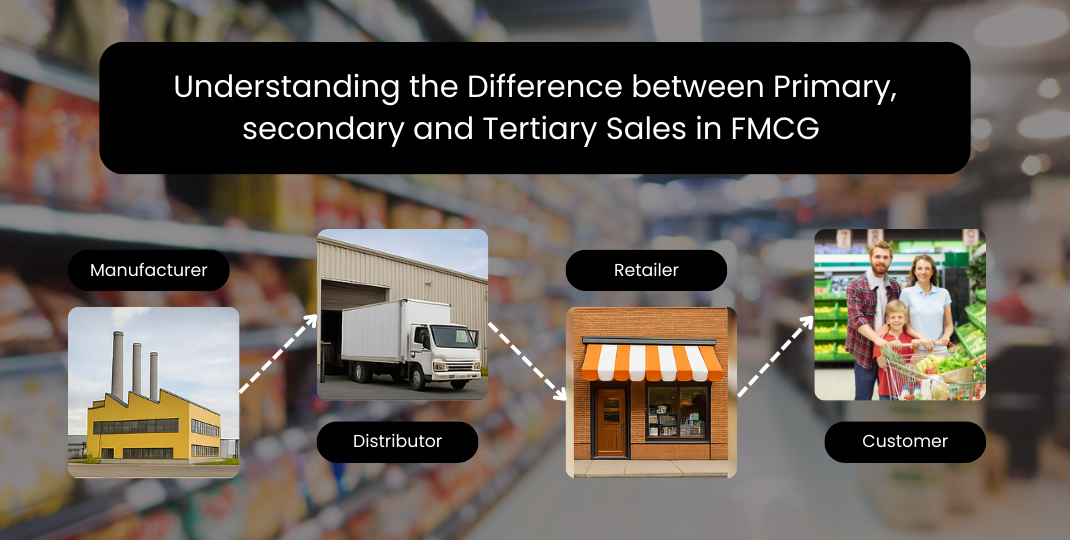In the FMCG business, it’s not just about how much product you make—it’s about how effectively you move it through the market.
Whether you’re a growing brand or an established player, understanding the difference between primary, secondary, and territory sales isn’t just helpful—it’s critical to scaling your operations and gaining market share.
But what do these terms actually mean in practice? And more importantly—how can you manage them better, respond to market changes faster, and compete with larger players who have bigger budgets?
In this detailed blog, we’ll break it all down:
1. What primary, secondary, and territory sales really mean
2. What factors influence each level of sales
3. How to improve performance across the chain
4. Smart strategies for mid-sized FMCG businesses to punch above their weight
Let’s dive in.
Primary Sales: From Manufacturer to Distributor
Primary sales refer to the movement of goods from the FMCG company to its distributors or stockists. This is often the first point of revenue recognition for the brand—but it doesn't always reflect actual market demand.
Think of primary sales as the engine ignition-not the destination.
What Influences Primary Sales:
1. Production Planning
Are you producing the right quantities based on real market needs?
2. Distributor Capacity
Can your partners handle the stock and push it downstream?
3. Scheme Design
Are your incentives aligned with order volume and frequency?
4. Cash Flow and Credit Terms
Flexible payment options can unlock higher order volumes.
5. Seasonality and Festive Cycles
Align stock push with demand peaks.
How to Manage It Smarter
1. Use data from secondary/retail sales to guide how much stock to push.
2. Regularly evaluate distributor performance using KPIs.
3. Avoid overstocking—channel stuffing might boost short-term numbers but leads to long-term chaos.
4. Implement a sales automation tool like SalesJump to track real-time dispatches and stock flow.
Secondary Sales: From Distributor to Retailer
Secondary sales refer to the sale of goods from the distributor to retailers, wholesalers, or stockists further down the chain. This is a better indicator of market demand than primary sales-and it's where execution becomes critical.
Secondary sales = real-world traction. If this isn’t happening, your stock will just sit in warehouses.
Key Influencing Factors
1. Retailer Margins & Schemes
Are you incentivizing shopkeepers adequately?
2. Distributor Sales Team Performance
Are sales reps actively covering their territories?
3. Route Discipline
Is the beat plan being followed regularly?
4. Product Availability & Fill Rates
Are retailers getting full orders on time?
5. Local Competition
Rivals may offer deeper discounts or faster turnaround.
Boost Secondary Sales with These Steps
1. Digitize sales rep activities with a mobile-first solution like SalesJump SFA.
2. Use geo-tagging and live beat tracking to monitor field coverage.
3. Offer tailored schemes based on retailer category and purchase behavior.
Use analytics to find underserved areas and redirect efforts accordingly.
Territory (Tertiary) Sales: From Retailer to End Customer
This is where the final battle is won or lost.
Territory (or tertiary) sales refer to the sale of your product to the actual consumer, via a retail outlet. It's the most accurate representation of brand acceptance and real demand in the market.
Without strong tertiary sales, retailers stop reordering, and your entire chain slows down.
Key Drivers of Tertiary Sales
1. In-Store Visibility
Are your products easy to spot? Are displays attractive?
2. Retailer Push
Will the shopkeeper recommend your brand over a rival?
3. Consumer Promotions
Are you running attractive offers or trial packs?
4. Price-Value Perception
Does your product justify the price point?
5. Availability Consistency
Stockouts = lost sales + lost trust.
Ways to Strengthen Tertiary Sales:
1. Invest in local branding and in-store POS materials.
2. Track market feedback through sales reps and digital forms.
3. Engage in community marketing or hyperlocal influencer tie-ups.
4. Run retailer loyalty programs to increase order frequency and upselling.
Understanding the Sales Chain as a Whole
Here’s how the three levels connect:
Primary Sale: Manufacturer → Distributor
Secondary Sale: Distributor → Retailer
Tertiary Sale: Retailer → Consumer
These aren’t isolated events-they’re interdependent. Weakness in one creates friction in the others.
1. Strong primary sales without secondary pull?
Distributors sit on unsold stock.
2. Strong secondary sales but no territory demand?
Retailers won’t reorder.
3. Strong territory sales but poor secondary planning?
Stockouts and missed opportunities.
That’s why you need visibility at all levels.
How Small FMCG Brands Can Compete with Giants
You may not have a 100-crore advertising budget—but you can build a smarter sales engine. Here’s how:
1. Dominate Niches, Not Everything
Don’t try to be everywhere. Focus on 2–3 geographies and go deep. Build relationships with local distributors, understand the customer base, and own that market.
2. Use Tech as Your Superpower
Big brands use ERPs and advanced tools. You can too SalesJump’s affordable SFA gives you:
- Order tracking.
- Beat plan coverage.
- Sales rep productivity.
- Stock flow analytics.
- All in real-time.
3. Retailer Loyalty Wins Battles
Visit regularly. Resolve issues faster. Offer better margins or schemes. If retailers like working with you, they’ll recommend your product, even when the competitor is more well-known.
4. Data, Not Gut Feel
Track what sells and where. Know which reps underperform. Identify SKUs with repeat orders. No more guessing games, data should drive every decision.
Final Takeaway: Visibility = Control = Growth
Primary, secondary, and territory sales are the backbone of your FMCG business. When you manage them well:
1. You avoid stock wastage
2. You serve the right markets at the right time
3. You outpace slower, less agile competitors
And with the right tools, even a lean team can run a tight, intelligent, and high-performance sales engine.
Want to Take Control of Your FMCG Sales Funnel?
SalesJump helps FMCG brands manage the full sales chain:
1. Track stock from factory to retailer
2. Monitor every rep’s movement and orders
3. Get instant visibility into high and low-performing territories
4. Run schemes, check coverage, and forecast demand-all from one dashboard
Book a free demo today and see how easy it is to scale faster and smarter.




